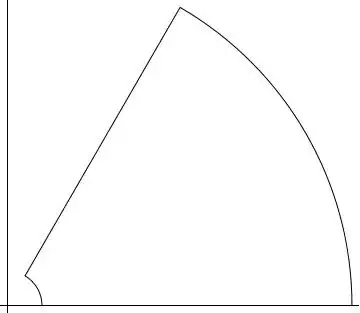$\newcommand{\bbx}[1]{\,\bbox[8px,border:1px groove navy]{\displaystyle{#1}}\,}
\newcommand{\braces}[1]{\left\lbrace\,{#1}\,\right\rbrace}
\newcommand{\bracks}[1]{\left\lbrack\,{#1}\,\right\rbrack}
\newcommand{\dd}{\mathrm{d}}
\newcommand{\ds}[1]{\displaystyle{#1}}
\newcommand{\expo}[1]{\,\mathrm{e}^{#1}\,}
\newcommand{\ic}{\mathrm{i}}
\newcommand{\mc}[1]{\mathcal{#1}}
\newcommand{\mrm}[1]{\mathrm{#1}}
\newcommand{\pars}[1]{\left(\,{#1}\,\right)}
\newcommand{\partiald}[3][]{\frac{\partial^{#1} #2}{\partial #3^{#1}}}
\newcommand{\root}[2][]{\,\sqrt[#1]{\,{#2}\,}\,}
\newcommand{\totald}[3][]{\frac{\mathrm{d}^{#1} #2}{\mathrm{d} #3^{#1}}}
\newcommand{\verts}[1]{\left\vert\,{#1}\,\right\vert}$
I start with the following rewriting
$\ds{\pars{~z^{\alpha} \mapsto z~}}$
\begin{equation}
\left.\int_{0}^{\infty}\!\!{\ln\pars{z} \over 1 + z^{\alpha}}\,\dd z\,\right\vert_{\ \alpha\ >\ 1} =
{1 \over \alpha^{2}}\int_{0}^{\infty}\!\!{z^{1/\alpha - 1}\ln\pars{z} \over
1 + z}\,\dd z\label{1}\tag{1}
\end{equation}
I'll consider
$\ds{\,\mc{I} \equiv
\oint_{\mc{C}}{z^{1/\alpha - 1}\ln\pars{z} \over 1 - z}\,\dd z}$. Both $\ds{z^{1/\alpha - 1}\ \mbox{and}\ \ln}$ are its
principal branches. The contour $\ds{\,\mc{C}}$ is a
key-hole one which 'takes care' of the above mentioned branch-cuts. Obviously, $\ds{\,\mc{I} = 0}$.
\begin{align}
0 & \,\,\,\stackrel{\mrm{as}\ \epsilon\ \to\ 0^{+}}{\sim}\,\,\,
-\int_{-\infty}^{-\epsilon}
{\pars{-x}^{1/\alpha - 1}
\exp\pars{\bracks{1/\alpha - 1}\ic\pi}\bracks{\ln\pars{-x} + \ic\pi} \over
1 - x}\,\dd x
\\[2mm] &
\phantom{\,\,\,\stackrel{\mrm{as}\ \epsilon\ \to\ 0^{+}}{\sim}\,\,\,\,\,\,}
-\int_{-\epsilon}^{-\infty}
{\pars{-x}^{1/\alpha - 1}
\exp\pars{-\bracks{1/\alpha - 1}\ic\pi}\bracks{\ln\pars{-x} - \ic\pi} \over
1 - x}\,\dd x
\end{align}
The integral around an indented semicircle around the origin and around a circumference with a radius $\ds{R \to \infty}$ vanish out and they were omitted in the above expression. Then, as $\ds{\epsilon \to 0^{+}}$,
\begin{align}
0 & =
\expo{\ic\pi/\alpha}\int_{0}^{\infty}
{x^{1/\alpha - 1}\bracks{\ln\pars{x} + \ic\pi} \over 1 + x}\,\dd x -
\expo{-\ic\pi/\alpha}\int_{0}^{\infty}
{x^{1/\alpha - 1}\bracks{\ln\pars{x} - \ic\pi} \over 1 + x}\,\dd x
\\[5mm] & =
2\ic\sin\pars{\pi \over a}
\int_{0}^{\infty}{x^{1/\alpha - 1}\ln\pars{x} \over 1 + x}\,\dd x +
2\pi\ic\cos\pars{\pi \over a}
\int_{0}^{\infty}{x^{1/\alpha - 1} \over 1 + x}\,\dd x
\end{align}
\begin{equation}
\bbx{\int_{0}^{\infty}{x^{1/\alpha - 1}\ln\pars{x} \over 1 + x}\,\dd x =
-\pi\cot\pars{\pi \over a}
\int_{0}^{\infty}{x^{1/\alpha - 1} \over 1 + x}\,\dd x}\label{2}\tag{2}
\end{equation}
The remaining integral is evaluated by a
similar procedure ( as the above one ). Namely:
\begin{align}
&\bbx{\int_{0}^{\infty}{x^{1/\alpha - 1} \over 1 + x}\,\dd x =
\pi\csc\pars{\pi \over a}}\label{3}\tag{3}
\end{align}
With \eqref{1}, \eqref{2} and \eqref{3}:
$$\bbox[15px,#ffe,border:1px dotted navy]{\ds{%
\left.\int_{0}^{\infty}\!\!{\ln\pars{z} \over 1 + z^{\alpha}}\,\dd z\,\right\vert_{\ \alpha\ >\ 1} =
-\pars{\pi \over \alpha}^{2}\cot\pars{\pi \over a}\csc\pars{\pi \over a}}}
$$
